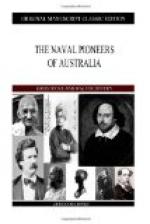“The tedious repairs which His Majesty’s ship [Sidenote: 1798] Reliance necessarily required before she could be put in a condition for again going to sea having given an opportunity to Mr. George Bass, her surgeon, a young man of a well-informed mind and an active disposition, to offer himself to be employed in any way in which he could contribute to the benefit of the public service, I inquired of him in what way he was desirious of exerting himself, and he informed me nothing could gratify him more effectually than my allowing him the use of a good boat and permitting him to man her with volunteers from the King’s ships. I accordingly furnished him with an excellent whale-boat, well fitted, victualled, and manned to his wish, for the purpose of examining along the coast to the southward of this port, as far as he could with safety and convenience go. His perseverance against adverse winds and almost incessant bad weather led him as far south as the latitude of 40 deg.00 S., or a distance from this port, taking the bendings of the coast, of more than 600 miles.” (This, remember, was accomplished in a whale-boat.) “He coasted the greatest part of the way, and sedulously examined every inlet along the shore, which does not in these parts afford a single harbour fit to admit even a small vessel, except a bay in latitude 35 deg.06, called Jarvis’ Bay, and which was so named by one of the transport ships, bound here, who entered it, and is the same called by Captain Cook Longnose Bay. He explored every accessible place until he came as far as the sourthermost [sic: southernmost] parts of this coast seen by Captain Cook, and from thence until he reached the northernmost land seen by Captain Furneaux, beyond which he went westward about 60 miles, where the coast falls away in a west-northwest direction. Here he found an open ocean westward, and by the mountainous sea which rolled in from that quarter, and no land discoverable in that direction, we have much reason to conclude that there is an open strait through, between the latitude of 39 and 40’12 S., a circumstance which, from many observations made upon tides and currents thereabouts, I had long conjectured.
“It will appear by this discovery that the northermost [sic: northernmost] land seen by Captain Furneaux is the southernmost extremity of this coast, and lays in latitude 39.00 S. At the western extremity of Mr. Bass’ coasting voyage he found a very good harbour; but, unfortunately, the want of provision induced him to return sooner than he wished and intended, and on passing a small island laying off the coast he discovered a smoke, and supposed it to have been made by some natives, with whom he wished to have an opportunity of conversing. On approaching the shore he found the men were white, and had some clothing on, and when he came near he observed two of them take to the water and swim off. They proved to be seven of a gang of fourteen convicts who




